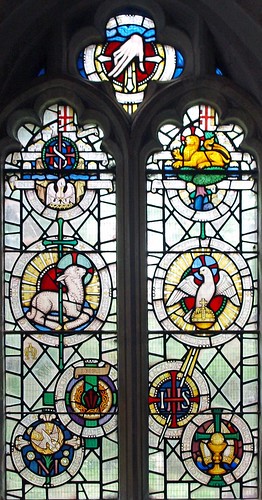My sledge and hammers be declined
My bellows too have lost their wind
My fires extinct, my forge decay'd,
My vice is in the dust all laid.
My coal is spent, my iron gone,
My nails are drove, my work is done.
My fire dried corpse here lies at rest,
My soul smoke-like soars to be blest
ST MARY. Of brown cobbles. Partly Dec and partly Perp. Early C14 the chancel with windows from the cusped lancet to reticulation. The DOUBLE PISCINA indeed looks no later than c.1300. Early C14 also the N arcade of standard elements. Perp W tower of unusual shape (but cf. more than
half a dozen in Cambridgeshire, the centre of course being Ely). The buttresses stop below the bell-openings, and above them the tower turns octagonal to carry the stone spire. The spire has two tiers of lucarnes, the square part of the tower very prominent pinnacles, the top parts of which unfortunately were blown off in the hurricane of 1741. The N aisle wall is a cheap brick rebuilding of 1871. - SEDILE. Stone seat, with arms like that at Stanground; C13 (N aisle, W end, not in situ). - PLATE. Early C17 Cup.
HOUGHTON. Those who love Constable will find here a picture he would have loved to paint, Houghton Mill. They should go across the river to see it from the Hemingford side, about a mile away, a point from which it is enshrined in a scene as fair as anything in our countryside. A charming
idler by the Ouse, it is a massive timbered building of the 17th century.
The old houses gather round Houghton’s Square, one of them a rare piece of beauty with its white walls. Near it is a bronze bust of a man the village wishes not to forget; he had the curious name of Potto Brown. Thereby hangs a tale. Potto Brown was a rich miller and a Nonconformist,
a devout man who believed profoundly that prayer is one of the mainsprings of men’s lives. He was quite sincere in taking his ledgers with him to family prayers and in telling God all about the debts that were owing to him; he would mention the debtors by name. As for his bust, it
happened that the village wanted one when Potto Brown died, but he had always refused to be photographed and there was nothing in existence save a slight pencil sketch of him. Near by lived a farmer named Albert Goodman who had never done anything artistic in his life; and Goodman
shut himself up from the world for several days, with a lump of plaster, and from the rough sketch produced this excellent portrait, since made in bronze and placed here for us to see.
The beautiful and lofty spire of the church gleams in the sun long before we reach it. It soars above a 14th century nave with a 13th century chancel. There is a rough stone seat 600 years old, a very fine piscina, and a pulpit made from a tree in Houghton Park.
We find on Houghton roll of honour the name of Leslie Green who died for us. He went out badly wounded under heavy fire to save a comrade entangled in the wire of No Man’s Land. He dragged his friend to a shell hole and dressed his wounds while bombs fell all around him, and he carried him to safety. Then he fell, and the VC was given to his widow.
Flickr.



No comments:
Post a Comment